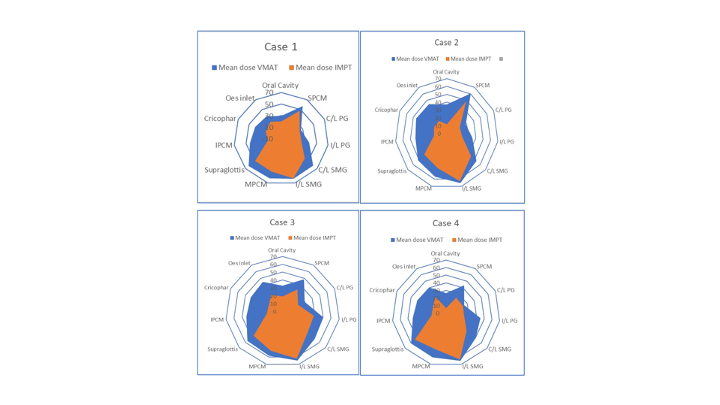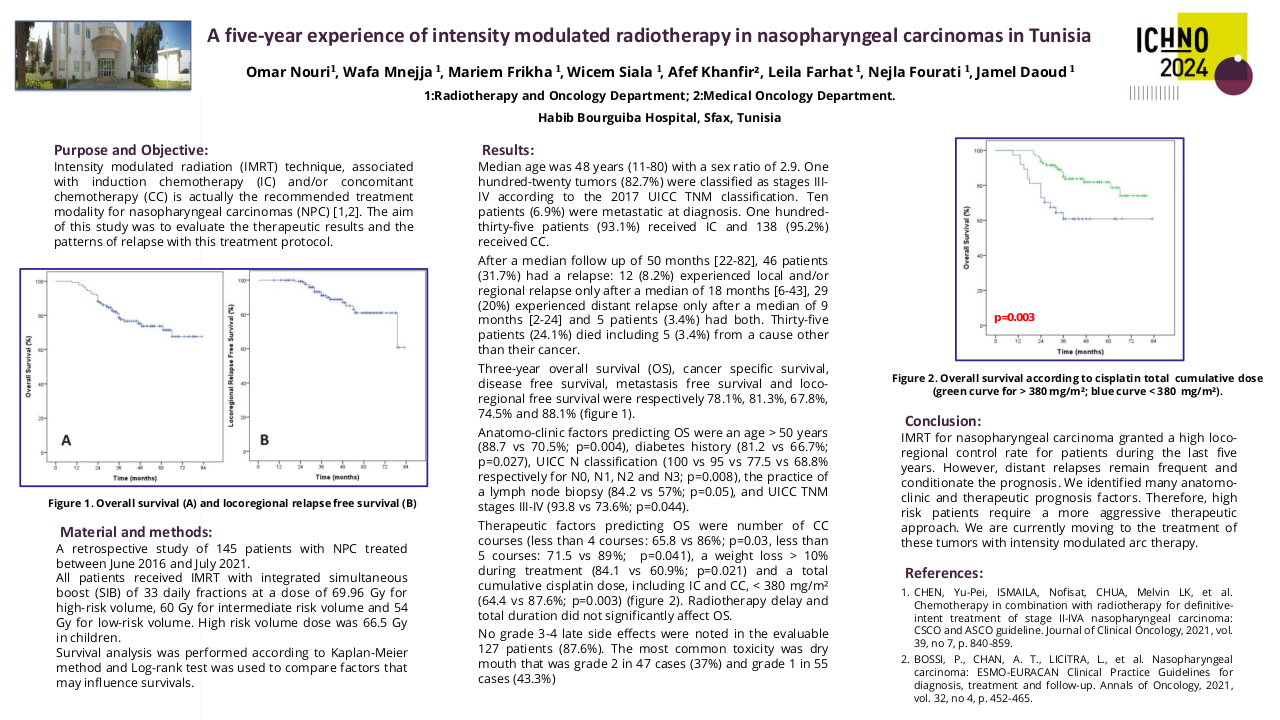Impact of biological response-based adaptive radiotherapy on doses to swallowing OARS in modelled IMPT plans
Purpose/Objective
The PEARL study is a phase 2 multi-centre trial for good prognosis HPV-associated oropharyngeal squamous cell carcinoma (OPSCC) patients, currently open in the UK. PEARL is investigating the dosimetric impact of re-planning a radical radiotherapy plan midway through a course of treatment, based upon the biological response of the primary GTV on 18 FDG PET-CT. With the wider availability of proton beam therapy in the form of Intensity Modulated Proton Therapy (IMPT) as a potential option for radiotherapy in the management of OPSCC, in addition to substantial cost implications, improving methods to determine the patients who will benefit most from IMPT is required. The organ sparing benefits of IMPT are well documented. This modelling planning study investigated whether the benefits of proton therapy can be improved by applying biological response-based adaptation as per the PEARL study planning method.
Objectives:
- Investigate the dosimetric impact of IMPT by comparing mean dose received by swallowing OARs (SWOARs) between non-adaptive VMAT and non-adapted IMPT plans
- Investigate the dosimetric impact of adaptation by comparing dose received by SWOARs between non-adaptive IMPT and adapted IMPT plans
- Investigate the relative dosimetric impact of adaptation by comparing dose received by SWOARs between adaptive VMAT and IMPT plans
- Identify whether adaptation as per the PEARL Study protocol would influence the delta normal tissue complication probability (ΔNTCP) threshold for proton beam therapy funding in The Netherlands
Material/Methods
Anonymized patient datasets were used to model VMAT and IMPT plans using RayStation and optimised for SWOARs.
The following plans were generated:
- ‘NON-ADAPTIVE’: Manually planned non-adapted VMAT
- ‘ADAPTIVE’: Manually planned adapted VMAT
- ‘NON-ADAPTIVE_PROTON’: Manually planned non-adapted IMPT
- ‘ADAPTIVE_PROTON’: Manually planned adapted IMPT
NTCP calculations for dysphagia risk we performed using the validated dysphagia model described by Christianen et al (1). Individual calculations were performed on each case comparing adapted and non-adapted VMAT plans to non-adapted IMPT plans to explore whether they reached the threshold for proton beam treatment funding as per The Netherlands scheme. Mean dose to the superior pharyngeal constrictor muscle and the supraglottis was entered into the following calculation:
1/NTCP = (1+𝑒)−𝑠
where s = -6.09 + (mean dose to the superior pharyngeal constrictor muscle x 0.057) + (mean dose to the supraglottis x 0.037)
Results
All cases had a reduction in their total mean dose to SWOARs, adapted as per PEARL, and planned with IMPT. The magnitude of impact was ranked in the same order for all cases, with optimisation reducing the total mean dose the least, and adapted IMPT the most. Cases 1 and 2, and Cases 3 and 4, demonstrated similar total mean dose reductions despite having different degrees of biological GTV reduction on the iPET-CT. Adaptation had the greatest impact on Cases 2 and 3 for both VMAT and IMPT plans.
Fig. 1 Radar diagrams for Cases 1 – 4 in the style of Tambas et al (2) demonstrating the difference in mean dose to OARs in modelled non-adaptive VMAT and IMPT plans
The NTCP differences between non-adaptive VMAT plans and non-adaptive IMPT plans were >10% suggesting these cases would be candidates for IMPT funding as as per the National Indication Protocol Proton therapy (NIPP) - head and neck cancer criteria in The Netherlands.
Conclusion
Whilst primarily limited by the small number of cases, we have demonstrated that IMPT markedly reduces doses to SWOARs compared to VMAT planning in line with widely published studies. We have also demonstrated that adaptation based on the biological response to the tumour after 2 weeks of chemoradiotherapy can further improve the tissue sparing already achieved with IMPT. This is the first study to demonstrate that SWOAR sparing by IMPT can be improved with biological response guided adaptive radiotherapy.
Our results are in line with published data that IMPT can spare many head and neck SWOARs to a greater extent than VMAT in the treatment of oropharyngeal cancers. In the cases studied here, the impact of IMPT on the mean dose to SWOARs was greater than the impact of adaptation, when compared to standard VMAT planning. However, there may be additional dosimetric benefit when IMPT is adapted to tumour response during a course of radiotherapy treatment, particularly dose to more caudal SWOARs.
In this small cohort, adaptation on VMAT plans was unlikely to have affected a decision for IMPT treatment as per the Netherlands NTCP-based algorithm.
Further work with a larger cohort of patients, as well as real-time studies to collect prospective clinical data on xerostomia and dysphagia rates, is required to properly investigate the clinical advantages of adaptive IMPT.
1. Christianen ME, van der Schaaf A, van der Laan HP, Verdonck-de Leeuw IM, Doornaert P, Chouvalova O, Steenbakkers RJ, Leemans CR, Oosting SF, van der Laan BF, Roodenburg JL, Slotman BJ, Bijl HP, Langendijk JA. Swallowing sparing intensity modulated radiotherapy (SW-IMRT) in head and neck cancer: Clinical validation according to the model-based approach. Radiotherapy and Oncology. 2016 Feb; 118(2): 298 - 3032. Tambas M, Steenbakkers RJHM, van der Laan HP, WOlters AM, Kierkels RGJ, Scandurra D, Korevaar EW, Oldehinkel E, van Zon-Meijer TWH, Both S, van den Hoek JGM, Langendijk JA. First experience with model-based selection of head and neck patients for proton therapy. Radiotherapy and Oncology 2020 Oct: 151; 206-213







